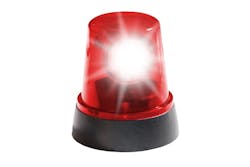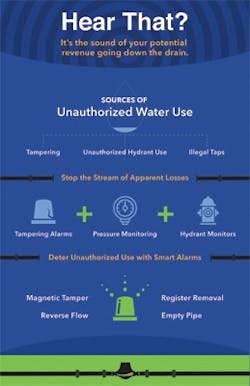Sound the Alarm
When it comes to identifying and managing apparent water loss, unauthorized use is one area of concern for utilities. An estimated 8% of non-revenue water (NRW) in North America is unauthorized. Water providers who actively address unauthorized use will see a positive impact on organizational revenue streams and a reduction in overall expenses.
Outdated metering infrastructure can make utilities particularly vulnerable to unauthorized use. It can be more difficult for technicians to identify when an older meter has been tampered with or if unauthorized water use has occurred. Moreover, if technicians are manually capturing meter reads each month, the window of opportunity in which to pinpoint the person responsible for the unauthorized use is much smaller.
Utilities cannot afford to miss out on meeting revenue potential due to unauthorized use. It is critical for utilities to understand the challenges associated with unauthorized use so they can make well-informed decisions that proactively address this concern.
A Three-Step Approach
To reduce unauthorized use, there are three strategies for utilities to consider: detection, deterrence and enforcement.
- Detection refers to the awareness of the act, or a utility’s ability to pinpoint unauthorized use when it occurs.
- Deterrence can be achieved in part through metering system design, with a focus on making it more difficult to access or obtain water.
- Enforcement refers to the due process of compliance with laws and associated rules.
In the past, water utilities primarily focused on deterrence to control unauthorized use. Meters were installed with a variety of security measures, including locks, fences, seal wires, and tamper-resistant screws and packaging. Typically, detection is not the focus until deterrence falls short. New capabilities can help utilities defend against unauthorized use, as advancements have bolstered deterrence efforts in addition to efficiently detecting unauthorized use.
Metering Technology Advancements
Smart meters improve velocity and pressure measuring for advanced detection of unauthorized use. Equipped with magnetic and electromagnetic sensors, these meters can measure accuracy across water flow, pressure and temperature. For example, a smart water metering system with sensors deployed within the bypass on a fire line meter will provide timely alerts of unauthorized use, even pinpointing the exact location of the problem.
Advanced detection is combined with smart water alarms, including leak detection, reverse flow, empty pipe, magnetic tamper and low battery. Smart meters typically are compatible with automatic meter reading and advanced metering infrastructure (AMI) systems, helping utilities quickly resolve issues with unauthorized use in the field.
When selecting a smart water meter, utilities should weigh the features against organizational objectives. Utilities also should consider how their meters will interact with other components of their network and infrastructure.
The Smart Water Network
Smart water meters can be combined with smart water network solutions to improve monitoring and management of unauthorized use in addition to reducing other forms of NRW. By integrating smart meters with an AMI system—including a reliable, two-way communications network and data analytics—utilities have the ability to remotely monitor their entire system in real time.
Upgrading to a smart water network enables utilities to prioritize maintenance issues and other aspects of their water distribution network. With features such as remote shutoff, turn-on and reduced flow, utilities have greater control over water resources, allowing them to turn water into revenue by reducing issues such as unauthorized use.
The data insights provided by a smart water network also show opportunities for increased deterrence. Because some systems send unauthorized usage alerts in real time, utilities can respond aggressively, minimizing the time between occurrence, action and enforcement.
Enhanced data acquisition allows utilities to use their smart water network for developing usage patterns and addressing potential cases of unauthorized use. Smart data also offers additional means for detection along with system alarm and maintenance functions. Providing the insight utilities need to understand usage trends and support strategic objectives, this data can be used to improve everything from efficiency to customer service.
While many utilities review monthly usage thresholds, modern AMI systems offer more advanced monitoring. By gaining data insights regarding usage, utilities can be more vigilant in managing their networks. Smart water systems provide short-term results in terms of revenue savings, but also serve as a system that is future-proof with an aim to support utilities for many years.
Building for the Future
As the industry continues to evolve, water likely will become more expensive due to the energy it takes to clean and move it. This is a trend that relates to both potable water and wastewater. As the price for water continues to escalate, so too will the lengths some users go to obtain water in an unauthorized manner.
With a smart water network in place—one that strategically aligns infrastructure, sensors and data—utilities can address unauthorized use and enhance the investments they have already made. As the future calls for more data and faster detection, utilities will need a system that quickly can scale to meet those needs and drive revenue for years to come.
About the author: Dan Pinney is vice president of water marketing for Sensus, a Xylem brand. Pinney can be reached at [email protected].
Editor's Note: The article information for this piece has been updated to reflect a change in title and contact email address on April 22, 2020.

